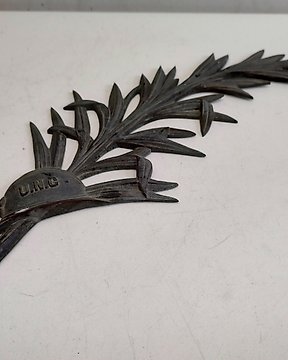
Branche de palmier français Vétérans - Accessoires militaires
Nº 84383709

Nº 84383709

Assembly of three antique samurai dolls 武者人形 (Musha ningyô):
Two samurai retainers in different dynamic poses wearing samurai armour (yoroi), silk yoroi’hitatare (trad. clothing under armour) and jingasa (warrior hats).
The plump pink one with eye inlaid with glass, and both with soft skin created by applying repeated layers of the pigment called gofun 胡粉, which is the refined powder of the itabo oyster (Ostrea denselamellosa).
Also a standing samurai wearing traditional Japanese samurai-class garments, a purple silk top and black-white dotted pants. Sword at his side, and holding a signal baton (saihai) in his hand.
Approx. dimensions :
Standing retainer:
Height 31 cm, Width 19 cm, Depth 15 cm.
Kneeling retainer:
Height 24.5 cm, Width 20 cm, Depth 11 cm.
Standing samurai:
Height 24.5 cm, Width 17.5 cm, Depth 14 cm.
Period: Japan – 19th century (Late Edo period/Early Meiji period).
Considering their age, the dolls and the costumes are in a good condition with traces of age and wear, like wear of fabric and gofun. For a clear condition reference, please take a close look at the photos.
Musha ningyô were displayed during Boy’s day. May 5 marks tango no sekku, which in Japan is also known as Boys’ Day. In Japan, the focus of tango no sekku was traditionally on male children, with decorations and specially prepared dishes intended to ensure that sons grew into healthy and prosperous adults. The emphasis broadened to include both boys and girls when the day was adopted as the national holiday Children’s Day in 1948. (From Nippon.com)
Comment acheter sur Catawiki ?
1. Découvrez des objets d’exception
2. Faites la meilleure offre
3. Effectuez un paiement sécurisé